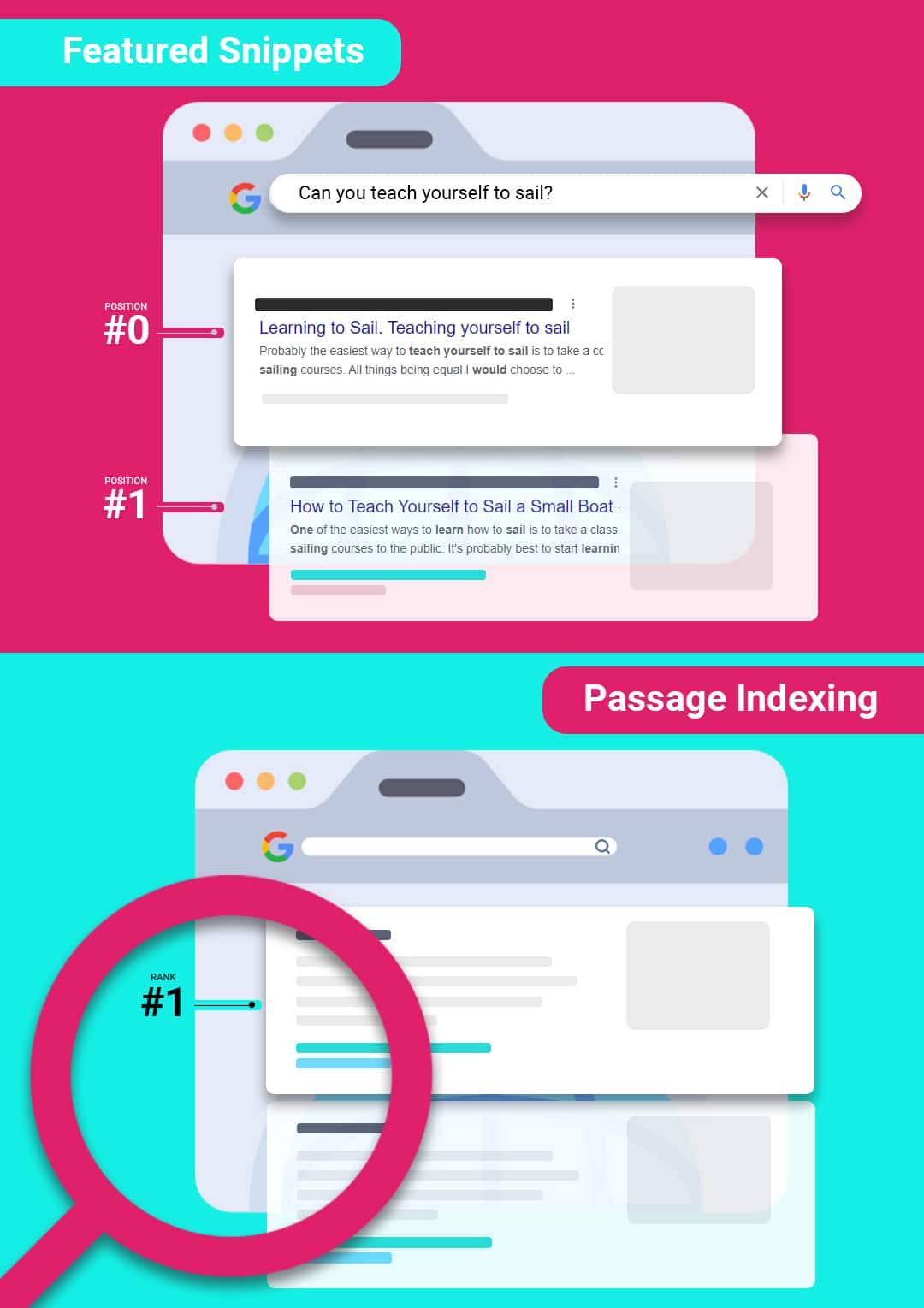Understanding Google Passages to Get Ahead on The Search Page
Whether running an online retailer or offering free online meeting services, visibility in Google search results is key. The competition for prime positions is, of course, intense—businesses are constantly jockeying for positions in search engine results pages (SERPs) in the hope of gaining an edge over their rivals.
If you have any previous experience of search engine optimization (SEO) or already use Google analytics–and let’s face it, you do–you’ll already be aware that Google loves to chop and change its algorithms every so often. It does so for users with more accurate and relevant search results, but for those who’ve worked hard to secure top slots in SERPs, it can bring all their hard work crashing down.
Book a Consultation
One such tweak is Google passage ranking, which Google announced in October 2020. The potential implications of this change have been much debated as businesses try to get to grips with what it might mean for their SEO performance. Google passage rankings are a relatively modest change for all the hype, but it’s important to understand the ramifications.
There are lots of ways you might succeed in getting ahead in Google’s SERPs. You might, for instance, use Google Display Network targeting to ensure that your ads are displayed to potential customers. Now, it’s important to get to grips with passage indexing and work out how you might make effective use of it.
In this guide, we’ll take a closer look at what the introduction of Google passage ranking means and the implications it might have for your website and its content. Before looking at its future benefits, we’ll start by explaining exactly what it is and how it works. Then we’ll look in closer detail at what repercussions it might have and discuss how you should adapt.

What is Google passage indexing?
As we’ve just been discussing, Google revealed in an October blog post that it had made a raft of changes, including the rollout of passage indexing. This immediately prompted a wide-ranging discussion in SEO circles, as people tried to make sense of what was happening—a process that happens whenever Google makes these tweaks.
In short, passage ranking pulls sections of content from web pages and displays them in SERPs. This might sound a lot like featured snippets—a long-established Google feature—but there are important differences, which we’ll come to subsequently.
This means that an individual section of a particular piece of content may be displayed in SERPs, even if the page from which it is drawn doesn’t rank for the search term specified.
So, say you’ve written a section about why a virtual chat agent might be useful in a longer guide to omnichannel customer service, but it doesn’t rank for the former search term. If Google thinks that section might be particularly relevant to a user searching for information on virtual chat agents, it might choose to display it via passage indexing.

What’s the difference between passage indexing and featured snippets?
As you might already be aware, featured snippets appear at the top of Google’s search pages. This is known as “position zero” because it appears above the top-ranking result for the particular query that’s being searched for.
For instance, let’s say you search for “SaaS pricing models” in Google. What might then happen is that a featured snippet appears in an answer box at the top of the results page, offering a bullet-point list of relevant examples and a link to the page from which they’ve been drawn. This is designed to help users find what they’re looking for more quickly and easily.
Again, this might all sound near-identical to passage indexing, as we’ve just described it. But there’s a key difference. Featured snippets are chosen according to the relevance of the entire website from which they’re taken to the search query at hand. Passage indexing works according to the relevance of individual passages in isolation.
In practice, this means that Google can draw on a far wider variety of content and bring it to users’ attention because it’s looking at specific sections of pages and deciding whether they’re relevant to the search query. If it decides that these passages are relevant to what a particular user is searching for, it will then present them in SERPs as the new Google Passages.

How does Google’s passage algorithm work?
As always with Google, there’s a degree of opacity about how its passage algorithm works. It’s still relatively new, and people are still trying to get their respective heads around it. But despite the term “passage indexing”, this is in fact a ranking change rather than an indexing one.
What does that mean? Well, it means there’s no particular change to how Google indexes its pages, but it does involve a change to how they’re ranked. In other words, pages may be ranked differently if they contain specific passages relevant to a particular search term.
Google’s indexing process—using bots to crawl and index pages—is unchanged, and Google is still indexing full pages. What Google’s passage algorithm does is isolate snippets of text and highlight them to users where they’re considered relevant. The page in question is then ranked on that basis.
It all sounds simple enough, but only time will tell what sort of effects the introduction of Google passage ranking will have, how it will work alongside featured snippets, and so on. At this point, however, it seems like a relatively modest adjustment rather than a wholesale overhaul. We’ll discuss the potential SEO implications at greater length later on.
Natural language processing
Another point that’s worth touching on here is Google’s use of natural language processing. Google has sought to make greater use of natural language processing, an AI-based technology, to help it better understand users’ search queries and deliver more appropriate results.
In 2019, Google introduced BERT, an update intended to facilitate more efficient processing of natural language. At the time, it was hailed as Google’s most important update in several years. In short, BERT processes the words entered into Google search queries in relation to one another, allowing the search engine to process conversational language better.
This shift towards natural language processing is also intended to reduce the effectiveness of attempts to game Google’s SERPs. Those whose experience with SEO stretches back a decade or so will recognize how much things have changed and how the keyword stuffing that was once de rigueur is now counter-productive, as Google punishes sites that try it.
In announcing the introduction of passage ranking, Google revealed that BERT was now being used across 100% of English-language searches. We don’t know exactly whether Google is using the introduction of technologies such as BERT in its passage ranking system, but it seems reasonable to conclude that it’s a possibility.
The rollout of NLP and many of the other changes Google has made to its algorithms and ranking methods are meant to encourage higher standards of content creation. If you’re creating content extolling the virtues of project management software, you’ll need to ensure that it’s genuinely good content; this means more than just putting sufficient numbers of keywords in the right places.

Benefits of passage indexing
If we’re going to make sense of passage indexing properly, we need to appreciate its potential benefits. This could help inform our content strategies in the future to understand better what Google will reward and what it won’t.
What are the potential benefits of passage indexing? As far as users are concerned, it should ensure that they’re presented with more relevant content that directly addresses their needs, enabling them to find the information they’re looking for—on, say, A/B testing strategies —with less hassle.
The focus on user experience is very important. As with its use of NLP, Google is trying to make it easier for users to find what they need. It was much easier to game Google algorithms in the past, which sometimes meant that substandard content was performing well in SERPs because it was well-optimized, even if it wasn’t serving user needs very well.
Google will no doubt hope that this encourages websites to concentrate more on the quality of their content. Optimizing for specific keywords may become less important, although long-tail keywords may grow in importance.
It appears that, with the arrival of passage ranking, Google is trying to reduce the emphasis on on-page SEO. Instead, the focus will be on content quality and its ability to provide the kind of information, expertise, and insight that users are looking for.
For content providers, therefore, passage indexing could have many upsides. In particular, it should provide longer-form content with some uplift in SEO rankings. Pages that cover multiple subjects could benefit from the introduction of passage ranking, as could some content that, for whatever reason, doesn’t use headings and subheadings.

What does passage ranking mean for SEO strategy?
Given that passage indexing appears to mark a shift away from on-page SEO, this could have a number of interesting implications for SEO strategy. Google always tends to play its cards close to its chest on these matters; it never gives too much away about its algorithms. But so far, it doesn’t seem to mark a major change in SEO best practices.
Nevertheless, the introduction of Google passages does appear to represent another step towards a quality-driven, rather than a keyword-driven approach to SEO. Increasingly, content providers are being asked to think about what it is they’re providing and whether or not it offers real value to users.
There was a time when it was just a matter of doing of keyword research to find what people were looking for and then bashing out some content to cater to that demand. Those days have long since passed. Keyword research is still important, but creating content purely for its sake won’t cut the mustard anymore.
None of this is to say that you should abandon the old methods of SEO optimization, such as backlinks, optimizing metadata, keyword targeting, and so on. But at the same time, you have to take content quality into consideration. Your content must be informative and authoritative rather than just being well-optimized.
Optimizing for passage indexing
The introduction of passage indexing could potentially benefit pages that offer good and relevant content without necessarily being well optimized for SEO. With that in mind, it might seem that optimizing for passage indexing is a contradiction in terms.
However, there are a few points you should perhaps bear in mind when creating content tailored for passage ranking. As we’ve emphasized repeatedly throughout this guide, quality is the key. There’s a long-established saying—content is king—and the arrival of passage ranking means that this is more important than ever.
Keyword research can still give you a good idea of the type of content that users are looking for, but you’ll need to ensure that it offers something distinctive when you create content to meet this demand., it offers something distinctive. The coherence and quality of your content should take precedence over keyword inclusion; keywords still matter, but the latter should not come at the expense of the former.
It seems that long-form content, in particular, is going to benefit from passage ranking. Again, don’t fall into the trap of creating long-form content simply for the sake of doing so or to fill a gap: If you’re going to create long-form content, it needs to serve a genuine purpose and provide genuine value.
You must also ensure that long-form content is well-written throughout its various sections. This maximizes its chances of being picked up by Google’s passage algorithm and displayed for relevant search terms. It would be best if you still optimized, but don’t assume that including them will be enough on its own to attract Google’s attention.
Above all, you should concentrate on the quality of your content. This is the direction in which Google intends to go, and you need to adjust your own content strategy accordingly. Instead of overthinking how to optimize for passage ranking, you should focus on creating excellent content. Let’s take a closer look at how you might do so.
Deliver quality content
What constitutes genuine quality content? A few factors instantly spring to mind: authoritativeness, originality, clarity, and detail. Furthermore, content should be concise and to the point, rather than rambling and sprawling. Precise passages, it would appear, are more likely to be looked on favorably by Google.
Moreover, your content should be designed to serve the needs of the people who might read it. Instead of worrying about what Google might think, it’s better to ask yourself what users might think. Before creating or posting a particular piece of content for a guest post or your website, you should think about whether you’re truly offering something that readers are likely to find useful.
All too often, in the past, websites effectively duped users with well-optimized content that didn’t offer much in the way of value. This is what Google has been trying to get away from, and passage indexing is part of that ongoing shift. Now, you need to ensure that your content is genuinely worthwhile for it to perform well in SERPs.
It’s not sufficient to crib content from other people’s websites, either. If you’re going to create content, it needs to be based on original insight and expertise. You should also avoid replicating content that’s already present elsewhere on your site, as Google may punish you for doing so. This has long been one of the most common SEO mistakes.
Understand what users are looking for
Finally, creating the kind of content that’s likely to be rewarded by Google’s passage ranking algorithm requires you to understand your audience. You need to have a good idea of the type of content that users might find useful.
Users are always looking for insightful and relevant content, but many different sites compete for their attention. It’s always a good idea to put yourself into the user’s shoes: If you were them, what sort of content would you like to see? Look at your existing content from a user’s POV and assess its strengths and weaknesses accordingly.
You must look at what competitor sites are doing. Analyze their content and ask what they’re doing right—and what they’re doing wrong. This could help you pick up on potential content opportunities and thereby gain an important competitive advantage. Perhaps there’s a gap for a good long-form guide to free website builders, for instance.
Once you’re equipped with this knowledge of what users are looking for and where good content opportunities might exist, you need to develop content—informed by robust keyword research—that’s well structured and well-optimized (also, don’t forget to optimize images for SEO). This is the kind of content that Google is actively looking to reward, including via passage indexing.
In conclusion, Google passage ranking is a subtle change that is part of a broader shift towards promoting authoritative, engaging content that meets user needs first and foremost. If this is reflected in your content strategy, you should be well-positioned to take advantage of Google’s changes.



